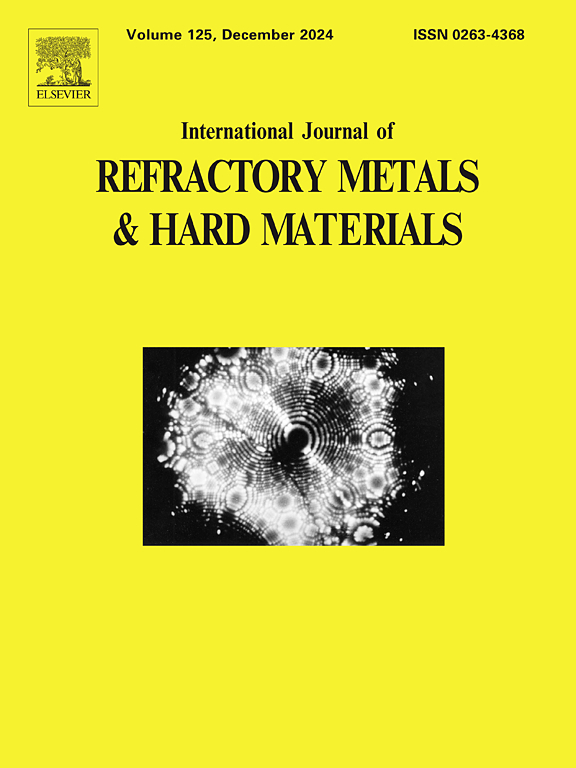Preparation, microstructure and mechanical properties of a Ce-PSZ reinforced molybdenum alloy
IF 4.2
2区 材料科学
Q2 MATERIALS SCIENCE, MULTIDISCIPLINARY
International Journal of Refractory Metals & Hard Materials
Pub Date : 2025-04-20
DOI:10.1016/j.ijrmhm.2025.107204
引用次数: 0
Abstract
Improving the poor plasticity and fracture toughness of molybdenum alloys is the key to expanding their industrial applications. In this experiment, a cerium partially stabilized zirconia (Ce-PSZ) reinforced molybdenum alloy with outstanding properties was obtained by combining the hydrothermal method and the powder metallurgy technology. This study investigated how varying Ce-PSZ content influences the microstructure and mechanical properties of Mo/Ce-PSZ alloys. The results show that with increasing Ce-PSZ addition, the relative density and hardness of the alloys gradually increase, while the tensile strength, plasticity, and fracture toughness exhibit a tendency to initially increase and subsequently decrease. When 1.5 wt% of Ce-PSZ is added, the Mo alloys achieve excellent overall mechanical properties, with an ultimate tensile strength of 528.5 MPa, elongation of 29.3 %, and fracture toughness of 38.5 MPa∙m1/2. These values are about 22.7 %, 22.5 %, and 83.3 % higher than those of pure molybdenum. The substantial enhancement in elongation and fracture toughness can be predominantly ascribed to the refinement of grains and the stress-induced Ce-PSZ phase transformation. This research provides a novel method for the preparation of molybdenum alloys with high fracture toughness and elongation.
Ce-PSZ增强钼合金的制备、显微组织及力学性能
改善钼合金较差的塑性和断裂韧性是扩大其工业应用的关键。本实验将水热法与粉末冶金技术相结合,获得了性能优异的铈部分稳定锆(Ce-PSZ)增强钼合金。研究了不同Ce-PSZ含量对Mo/Ce-PSZ合金组织和力学性能的影响。结果表明:随着Ce-PSZ添加量的增加,合金的相对密度和硬度逐渐增大,抗拉强度、塑性和断裂韧性呈现先增大后减小的趋势;当Ce-PSZ添加量为1.5 wt%时,Mo合金的综合力学性能优异,极限抗拉强度为528.5 MPa,延伸率为29.3%,断裂韧性为38.5 MPa∙m1/2。这些值分别比纯钼高22.7%、22.5%和83.3%。延伸率和断裂韧性的显著提高主要归因于晶粒的细化和应力诱导的Ce-PSZ相变。该研究为制备高断裂韧性和伸长率的钼合金提供了一种新方法。
本文章由计算机程序翻译,如有差异,请以英文原文为准。
求助全文
约1分钟内获得全文
求助全文
来源期刊
CiteScore
7.00
自引率
13.90%
发文量
236
审稿时长
35 days
期刊介绍:
The International Journal of Refractory Metals and Hard Materials (IJRMHM) publishes original research articles concerned with all aspects of refractory metals and hard materials. Refractory metals are defined as metals with melting points higher than 1800 °C. These are tungsten, molybdenum, chromium, tantalum, niobium, hafnium, and rhenium, as well as many compounds and alloys based thereupon. Hard materials that are included in the scope of this journal are defined as materials with hardness values higher than 1000 kg/mm2, primarily intended for applications as manufacturing tools or wear resistant components in mechanical systems. Thus they encompass carbides, nitrides and borides of metals, and related compounds. A special focus of this journal is put on the family of hardmetals, which is also known as cemented tungsten carbide, and cermets which are based on titanium carbide and carbonitrides with or without a metal binder. Ceramics and superhard materials including diamond and cubic boron nitride may also be accepted provided the subject material is presented as hard materials as defined above.

 求助内容:
求助内容: 应助结果提醒方式:
应助结果提醒方式:


